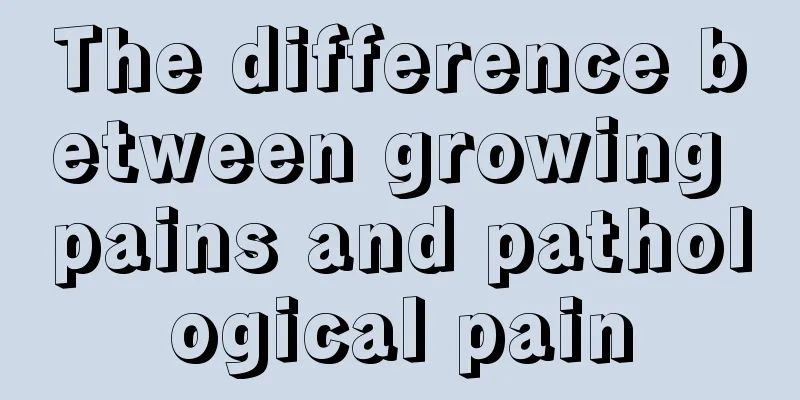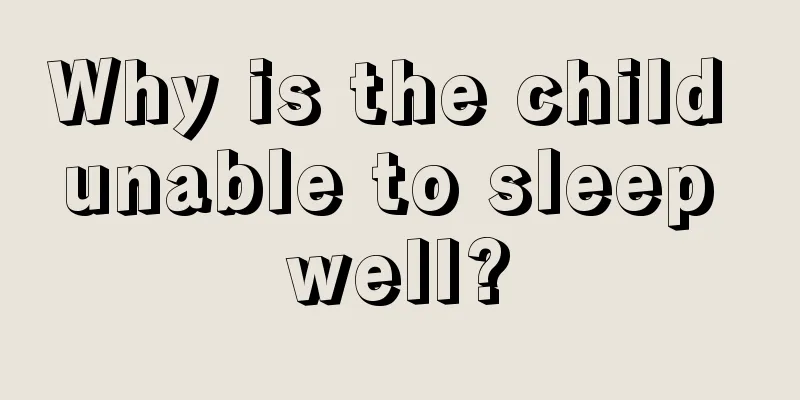The difference between growing pains and pathological pain

|
When children are growing up, they often tell their parents that they have pains here and there, but when they go to the hospital for a check-up, there is nothing wrong. Over time, parents will develop a "wolf" mentality towards their children's behavior, which leads to the children not seeking timely medical treatment when they really become ill, thus delaying the disease. Below I will introduce to parents the differences between growing pains and pathological pains. Parents must learn about them. 1. Growing pains often occur in the middle of the nightDoctors point out that growing pains often occur in children aged 5 to 10 who are still growing. If a child's bones grow faster than his muscles during his growth period, the muscles will be pulled and pain will occur. This is a normal growth phenomenon and parents do not need to worry at all. This type of growing pain is easy to identify. It usually occurs in the middle of the night and may cause numbness or pain in the knees, ankles, and knee joints. The degree of pain may be mild or severe and will disappear after a few nights. The next time it occurs it will last for a few nights before disappearing. There is no redness or swelling in the legs, there is no pain when pressing the leg muscles, and it does not affect walking.
When growing children have leg pain, many parents will associate it with calcium deficiency. But in fact, calcium supplementation has nothing to do with growing pains. Children with sufficient calcium may also experience growing pains, and calcium supplementation is not very helpful in relieving growing pains. There is no relationship between growing height and growing pains. Having growing pains does not necessarily mean that you will grow tall. Children without growing pains may also grow very tall. 3. How to relieve growing pains Since it is not a pathological phenomenon, is there any way to relieve growing pains? Doctors say that growing pains are normal and no measures need to be taken. Taking some vitamin B1 and vitamin B6 can nourish the nerves and relieve nerve traction pain, but the effect is not great. It should be noted that you should never take painkillers casually, and the pain is not severe enough to require medication.
Growing pains are muscle pains that are intermittent; juvenile arthritis will cause redness and swelling of the joints, and the location of the pain will change; pathological bone pain lasts a long time and is very intense; sprains or fractures will cause pain when pressed, and the fracture site will be red and swollen; childhood leukemia may also cause bone pain, but may be accompanied by symptoms such as fever, anemia, pale complexion, and pain in both bones and joints. |
<<: 1. The area around the child's anus is red, painful and itchy
>>: The back of the baby's hand was swollen due to mosquito bites
Recommend
What should children eat when they have tracheitis and cough?
Coughing is a more obvious symptom in children su...
How to bathe a newborn in winter
The weather is very cold in winter so people don’...
What to do if your child has poor memory
Generally speaking, children have very good memor...
What to do if your child drools while sleeping
Drooling seems to be a very normal thing for chil...
How to regulate children's weight?
Parents will be very anxious if they see their ch...
The harm of having no half-moon on baby's nails
Many parents become very worried when they find t...
What is the respiratory rate per minute of a newborn baby?
From birth, every movement of a newborn's bod...
The harm of general anesthesia surgery to children
Children's physical health is very important,...
How to solve the problem that children don’t like to study?
Nowadays, many parents are very distressed about ...
Precautions for adding egg yolk complementary food to babies
The yolk is the most nutritious, easiest to diges...
1 year 2 months old baby recipes and how to make them
The 1 year and 2 month old baby has grown up and ...
What is the best age for children to go to school?
Going to school is a necessary step in the proces...
What should I do if my child’s feet smell?
Some people in life like to sweat and then have s...
Tips on dressing your baby in winter
Everyone has different choices of clothing in win...
What's wrong with the blisters on my child's hands?
Children's skin is always soft and smooth, ma...









